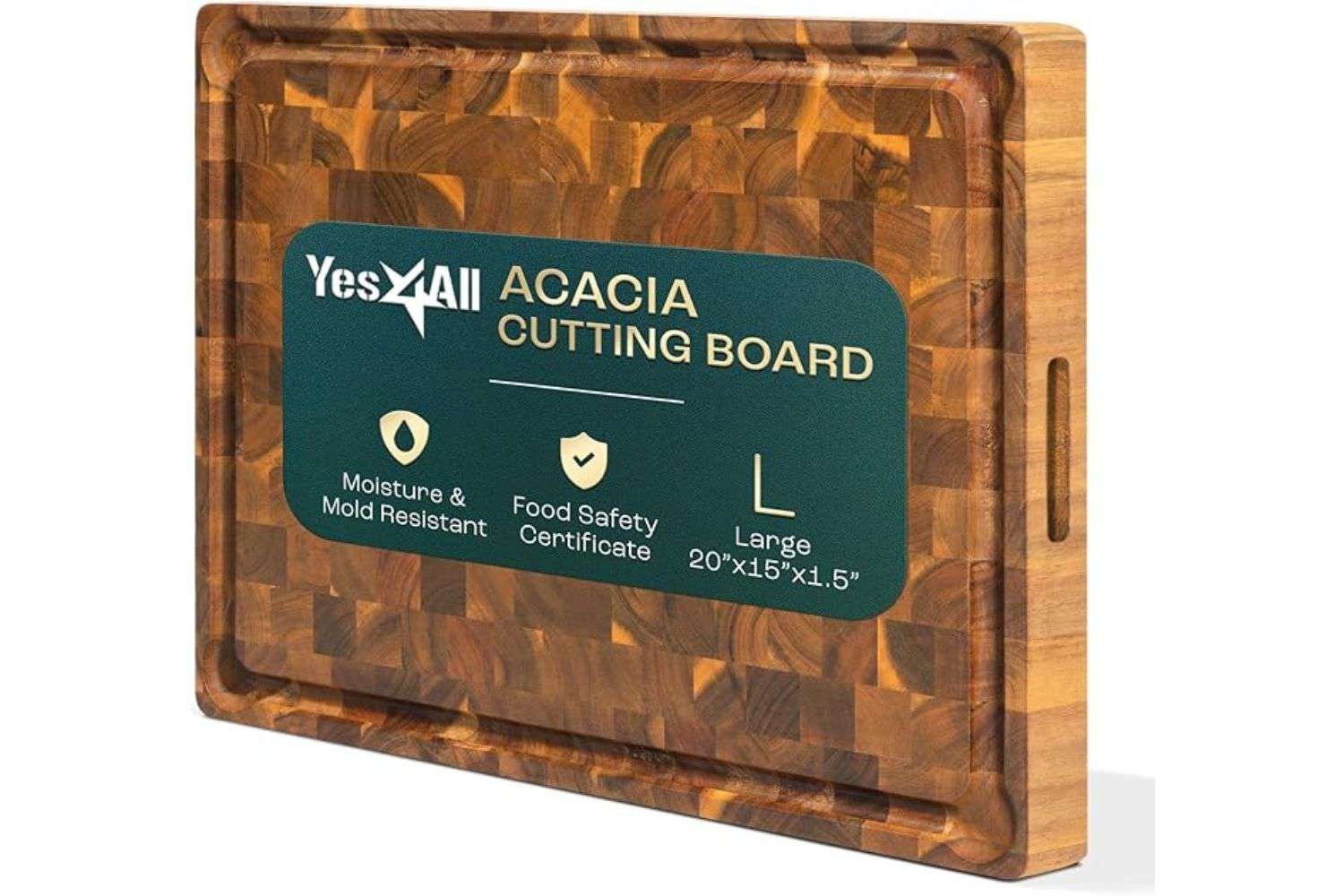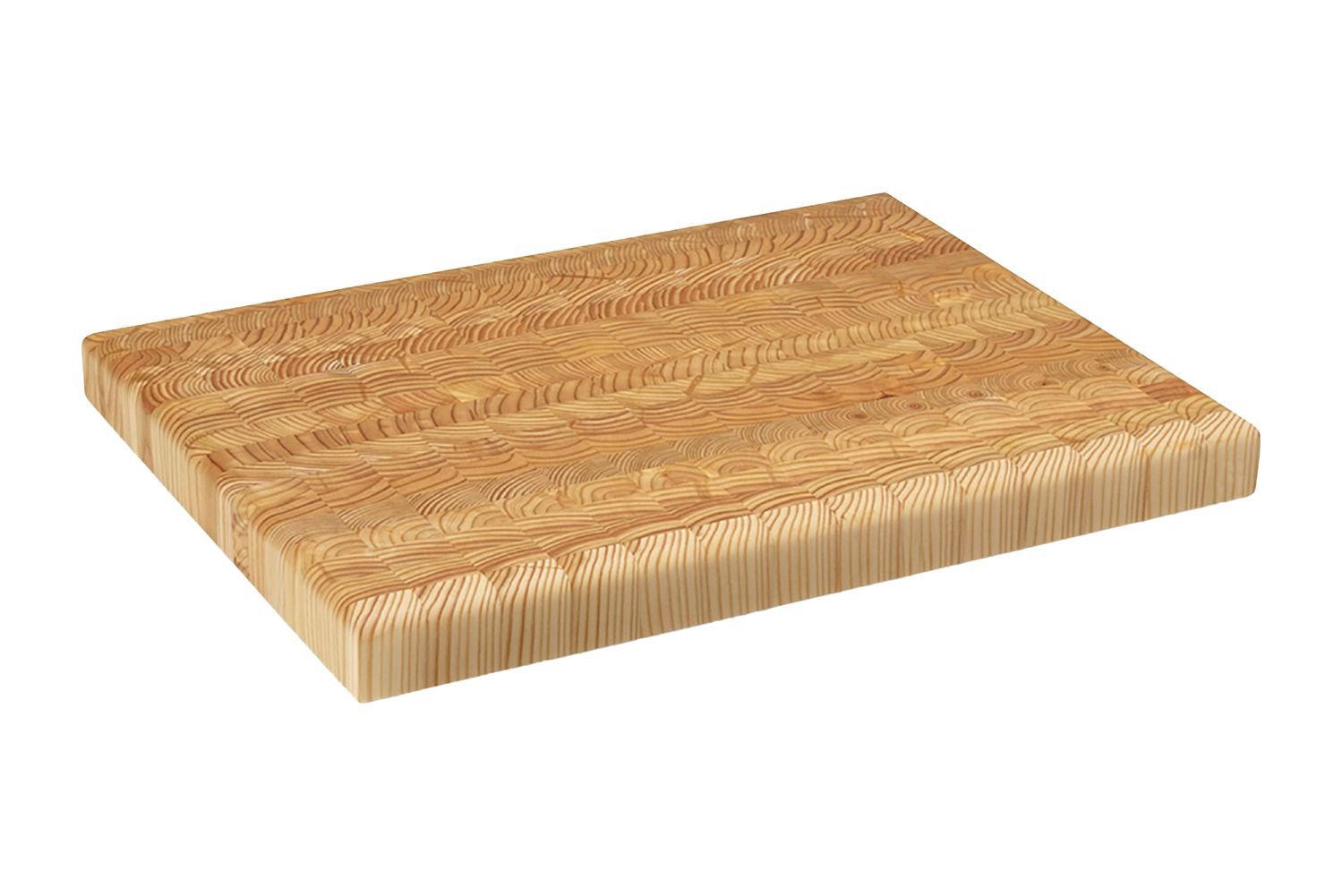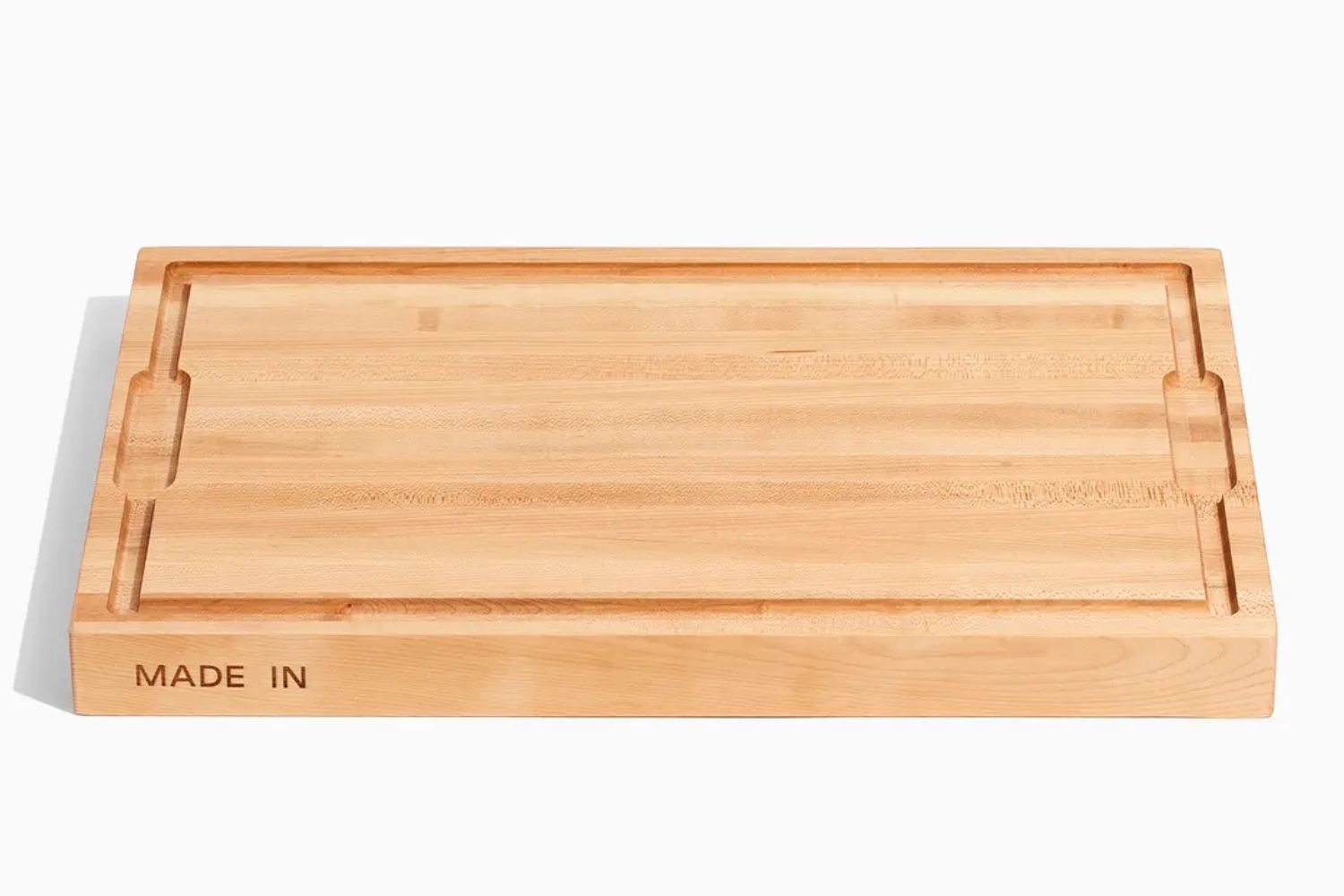
| Pros and Cons: End vs. Edge-Grain | ||
|---|---|---|
| Board Type | Pros | Cons |
| End-grain | Gentle on knives Less prone to marks |
More expensive Can split/warp at seams |
| Edge-grain | Cheaper Fewer seams and therefore fewer weak points |
Harder on knives More prone to gashes and gouges |
Both edge- and end-grain boards have weak points and can split and warp. In edge-grain boards, this is along the vertical fibers that you’re cutting into. My father-in-law, who is a carpenter, explained that edge grain is also more prone to expanding and contracting, leading to cracks. At furniture shows, he’s seen tables made of slabs of end-grain wood split when the weather and humidity change.
In end-grain boards, fissures are prone at the seams where the blocks are joined together. That said, I’ve used my Boardsmith end-grain board near-daily for years, and I’ve had no issues with warping or splitting at the seams.
The final point of difference is in price: End-grain boards are often more expensive than edge-grain boards since they’re made up of many pieces of wood glued together.
Which Size Should You Buy?
Serious Eats / Grace Kelly
While I lean towards a larger board (more space for cutting and holding food scraps), a board can be too big. The RVA Cutting Board measured 24 by 16 inches and barely fit on my countertop. The Boardsmith Carolina cut size was a smidge smaller, at 22 by 16 inches, though I still had trouble washing it in the sink (it’s also quite heavy at 23 pounds). Both of these boards are sold in smaller sizes, so I advise measuring your sink and countertop before deciding which to buy. Associate editorial director Riddley Gemperlein-Schirm prefers the slightly smaller Boardsmith Butcher size, which is 18 by 12 inches. The medium Larch board I tested, which is 13.5 by 18 inches, was a great Goldilocks size—neither too big nor too small.
Thickness is also important. A thinner board can’t be sanded down as often as a chunkier one, but a board that’s thicker than two inches, like the three-inch one from Crate & Barrel, can sit too high and make cutting uncomfortable. The sweet spot is around two inches.
Wood vs. Plastic Cutting Boards
Serious Eats
Sure, plastic cutting boards are cheap and convenient (most are dishwasher-friendly). But, they’re also way less durable than wood and are prone to bacterial buildup in any gashes on the surface. Conversely, wood actually has antibacterial properties. The NLM paper I mentioned previously notes that “the transfer of microbes from the wooden contact surface to food is lower as compared to other surfaces.” The paper cites a 2016 study that found “the transfer rates of Listeria monocytogenes from wood (0.55%) to cheese was lower than perforated plastics (1.09%) and glass (3%).” As previously mentioned, this is partially because the wood actually traps and seals over the bacteria. So, you should still give your board a good scrub with warm, soapy water after spatchcocking an uncooked chicken on it.
All this to say, sure, you can keep a few beater plastic boards on hand for days when you don’t want to wash a ginormous wooden board (I know I feel this way), but a wooden board will last longer and is less prone to bacterial buildup.
How to Maintain a Wooden Cutting Board
Serious Eats / Nick Simpson
A quality wooden cutting board ain’t cheap, and as my mom always reminded me, if you take care of your stuff, you won’t waste your money. Plus, maintaining a wooden cutting board is easy. After washing your board, dry it thoroughly then stand it up and let it air dry some more—moisture equals mildew (and can also cause warping and splitting). Once a month, wipe the clean, dry board with food-safe mineral oil (let it dry standing upright), keeping that primo board from drying out. Acacia and teak don’t dry out as quickly as hardwood, but they could still use a rub with oil now and then. And if your board is looking beat up, you can always grind away the surface layer with a sander and then rub it with some mineral oil or board conditioner.
The Criteria: What to Look for in a Wooden Cutting Board
Serious Eats / Grace Kelly
A wooden cutting board should be gentle on knives. Sure, sharpening blades isn’t a huge deal, but you don’t want to do it more often than you need to. While edge-grain boards have their merits, I prefer thick, well-made end-grain boards because they’re easy on blades while being durable enough to last years. There’s also less of a risk of warping and splitting than an edge-grain option. Finally, while acacia and teak options are cheaper (and there are some decent options out there), hardwood maple or walnut boards are less likely to beat up your blades. When it comes to size, bigger is generally better, though I found the sweet spot was between 18 to 22 inches long and 13.5 to 18 inches wide. Any larger, and it might be tough to fit the board on your countertop or in your sink for cleaning.
Our Favorite Wooden Cutting Boards
What we liked: This has been the Serious Eats team’s go-to cutting board for practically forever. I’ve had mine for three years, and it’s still in fantastic condition: there are no deep gashes and it has a pin-straight profile. Not only is it thick, durable, and soft on knives, but you can tell it’s a quality product. When you buy a board from the Boardsmith, it arrives nestled into a box, swathed in board butter, and in pristine condition. The edges are clean and the surface is smooth without any blemishes or gap fillers. The end-grain pieces are arranged in a sturdy bricklayer formation and stuck together with Titebond 3 waterproof glue. Oh, and the customizations! Not only can you get this board in three different sizes, but you can also add finger grooves for lifting and carrying and a juice groove (on the top or bottom). You can also remove the feet.
What we didn’t like: I tested (and have owned) the Carolina size (16 by 22 inches), which is a smidge big for my liking in terms of cleaning. I have to prop it up in the sink and use the sprayer to rinse it, inevitably getting water everywhere. The board is also thick, and it stands up quite a bit from a standard countertop, which takes some getting used to when cutting. However, if you want to go down a size, the 12-by-18-by-2-inch board is an editor favorite (and easier to fit in the sink).
Key Specs
- Available sizes: 12 x 18 x 2 inches; 16 x 22 x 2 inches; 18 x 24 x 2 inches; and custom orders
- Customizations: Finger grooves, juice groove, feet
- Weight: 23 pounds (18- x 24- x 2-inch option)
- Wood: Maple
- How to maintain: Wash and dry thoroughly; regularly treat with food-grade mineral oil and/or board butter
What we liked: While cherry is softer than maple, this board barely registered a scratch even when I used a new serrated bread knife to cut a crusty loaf on it. Each piece of end-grain cherry was identical in size and the seams were neat. The 20- by 16-inch size was spacious without being clunky, and you can add a juice groove, handles, and feet to the board.
What we didn’t like: The board’s finish isn’t quite as buttery smooth as the Boardsmith and the wood had some natural blemishes, though they were superficial.
Key Specs
- Available sizes: 12 x 18 x 1.75 inches; custom orders also available
- Customizations: Juice groove, handles, feet
- Weight: 12.2 pounds
- Wood type: Maple
- How to maintain: Hand-wash and thoroughly dry; coat with food-grade mineral oil every few weeks
Serious Eats / Grace Kelly
What we liked: This pretty acacia offering is easy on the wallet and the arms—it weighs a mere seven pounds, 16 pounds less than the Boardsmith. While acacia is harder on knives than say, walnut, this board didn’t dull a chef’s knife even after 200 strokes. It was our previous budget pick and my colleagues have noted it’s held up well over the years.
What we didn’t like: The surface is sleek and hard, so scratches show up more readily. While it has small feet grips, it did slide a little on my countertop.
Key Specs
- Available sizes: 20 x 14 x 1.25 inches
- Customizations available: None
- Weight: 7.2 pounds
- Wood type: Acacia
- How to maintain: Hand-wash and thoroughly dry; coat with food-grade mineral oil every few weeks
Serious Eats / Grace Kelly
What we liked: A mass-produced, sub-$60 acacia board will never compare to a beautifully crafted, $200-plus maple butcher block. However, if you’re looking for a budget pick, it’ll do the trick. The end-grain wood pattern was gentle on my chef’s knife, only dulling it 10.5%. The board scratched very slightly, and it cleaned up nicely after a wash and brush with mineral oil. I like that you can flip it over to use the side without the juice groove, which takes up a decent amount of the cutting surface.
What we didn’t like: While hefty, it looks cheaply made with rough edges and untidy seams. The juice groove also eats up surface space. I’ll continue to use this board as part of long-term testing to examine its longevity and durability.
Key Specs
- Available sizes: 20 x 15 inches; 17 x 13 inches; 24 x 18 inches; 16.5 x 13 inches; round option also available
- Customizations: NA
- Weight: 9 pounds
- Wood: Acacia (also available in teak)
- How to maintain: Wash and dry thoroughly; regularly treat with food-grade mineral oil and/or board butter; sand surface as needed
What we liked: Whenever I had friends over whilst testing cutting boards, this was the one that received oohs and ahs. And with good reason—it’s visually arresting, stopping you in your tracks with the woods’ swirls and whirls. But beyond its good looks, it also held up to my battery of tests and only incurred minor scratches. It was gentle on knives, too, and the 17- by 13-inch size was compact without feeling cramped.
What we didn’t like: It got a bit stained after I diced a sweet potato. It’s made of smaller end-grain pieces, so there are more seams, which increases the chance of splitting or cracking over time. It dulled knives a little faster than the other winners, though by a negligible amount.
Key Specs
- Available sizes: Large: 21.6 x 13.5 x 1.75 inches; medium: 17.75 x 13.5 x 1.6 inches; small: 17.75 x 11 x 1.5 inches
- Customizations: None
- Weight: 8 pounds (medium size)
- Wood type: Larch wood
- How to maintain: Hand-wash and thoroughly dry; coat with food-grade mineral oil every few weeks
Serious Eats / Grace Kelly
What we liked: This board was gentle on knives; there was barely any dulling after I ran a new chef’s blade over its surface. While there were some visible cut marks, they were shallow and healed over, making them virtually invisible. The 18- by 12-inch size hit the sweet spot: It’s spacious but also easy to move and clean.
What we didn’t like: End-grain boards just aren’t as durable or gentle on knives as edge-grain ones. One edge of the board was uneven.
Key Specs
- Available sizes: 18 x 12 inches
- Customizations: Can add a personalized engraving
- Weight: 8 pounds
- Wood: Maple
- How to maintain: Wash and dry thoroughly; regularly treat with food-grade mineral oil and/or board butter; sand surface as needed
The Competition
- Schmidt Bros 18″ End-Grain Butcher Block Cutting Board: This ultra-cheap board held up well during my tests. Scratches were minimal, and it barely dulled a brand-new chef’s knife. My only hesitation is that it has many poor reviews due to the wood splitting over time. Whether this is due to user error or board quality is uncertain, but I couldn’t in good conscience fully recommend it. I’ll keep using it as a part of long-term testing and update this article accordingly.
- Caraway Large Cutting Board: This birch edge-grain board was too soft. It got deep scratches even after light cutting tasks, and it stained readily. The juice well took up a lot of space.
- JK Adams Professional End Grain Walnut Board: This board performed well in all my tests, and I loved the dark walnut. However, there were smaller end-grain pieces interspersed with the larger blocks, and it had a rough finish. While not dealbreakers, I’d expect better from the priciest board I tested.
- Crate & Barrel Rectangular End Grain Cutting Board: This acacia wood board is three inches thick—that’s an inch more than the already hefty Boardsmith. It stood high on the countertop, which made cutting awkward for this five-foot-four tester. It also dulled a chef’s knife 116% after 200 strokes.
- Williams Sonoma End-Grain Cutting Board, Maple: This end-grain board performed well and is reasonably priced. However, it seems to be frequently out of stock and at one point after testing was swapped with a board with a sizable juice groove.
- JonesCuttingBoards Maple End Grain Butcher Block: The quality of this board wasn’t as good as the Brooklyn Butcher Block, even though it’s a similar price. It had a rough patch in one corner and smaller chunks of wood tucked between the larger end-grain pieces.
- RVA Cutting Board Solid Cherry Wood Board: Pieces of wood flaked off with each cut on this large edge-grain board.
- Shun Hinoki Cutting Board: Hinoki wood is very soft and is super gentle on knives—and this held true in my tests. However, this thin board was prone to deep gashes and gouges and it stained easily.
- John Boos Boos Block CB Series Large Reversible Wood Cutting Board: This board was okay. However, the bread knife deeply gouged the surface and the board’s edge was uneven in spots. It’s also quite large.
- Ziruma End Grain Teak Wood Cutting Board: This small board would be better suited for charcuterie rather than as an all-purpose cutting board. The juice groove took up a lot of cutting space. It seems to be out of stock in the size we tested.
- Sonder Los Angeles End Grain Walnut Wood Cutting Board: While this board performed well, the Ironwood acacia board was equitable and less than half the price.
- Choice 20″ x 15″ x 1 3/4″ Wood Cutting Board: This was one rough-cut board! Pieces of wood chipped off with each chop and slice of a knife.
FAQs
How do you clean a wooden cutting board?
The best way to clean a wooden cutting board is with a sponge, soap, and some elbow grease. Once cleaned, dry it thoroughly and let it stand up to air dry. Never put a wooden board in the dishwasher (I don’t even know how you’d fit the Boardsmith into your dishwasher!), since the high heat can warp it and it’ll become saturated.
What oil should you use for a wooden cutting board?
Food-grade mineral oil is a great option, but you can also buy balms, waxes, and “butters” sold specifically for wooden boards. Oiling your board keeps it from drying out, helps seal over scratches, and prevents stains and odors from seeping into the fibers.
Are wooden cutting boards safe?
Yes, as long as you properly clean and dry your board. If you’re worried about cross-contamination, having multiple boards on hand and designating one or two to proteins is a safe bet.
Is acacia wood good for cutting boards?
Acacia has more silica in it than, say, maple, which makes it harder and means it’s tougher on blades. That said, we did find a good acacia wood pick that was gentle on knives in our tests.
What’s the best cutting board to avoid bacteria?
End-grain boards are thought to be better at preventing bacterial growth because the concentric rings trap bacteria, and they die (mwahaha). That said, you should still thoroughly wash your board after using it.
How long do wooden cutting boards last?
When maintained properly, a high-quality wooden cutting board can last a decade or longer. It’s time to replace it, however, if it becomes splintered or severely warped.
How do you choose a wooden cutting board?
In my tests, end-grain boards came out on top: They are durable but also gentle on knives. Size and weight are personal, so measure your countertop and consider your sink size when deciding. Price often corresponds to material, e.g. a maple board will likely cost more than an acacia one. Different woods have pros and cons, and you will pay more for a more durable board.
Why We’re the Experts
- Grace Kelly is a senior editor at Serious Eats, where she’s been testing equipment for nearly three years.
- Before this, she was a reviews editor at America’s Test Kitchen.
- For this review, Grace tested 18 wooden cutting boards. She examined how much they dulled knives (if they did at all), cut bread on them with a serrated knife, and used the winners in her daily food prep routine for weeks.
- She’s had a Boardsmith End-Grain Maple board for more than three years, and it’s still in pristine condition.
- Daniel Gritzer first tested wooden cutting boards in 2019. His favorite from that testing, the Boardsmith, is still our winner.




